Follow javascript: SP.SOD.executeFunc('followingcommon.js', 'FollowDoc', function() { FollowDoc('{ListId}', {ItemId}); }); 0x0 0x0 ContentType 0x01 1100 Compliance Details javascript:if(CalloutManager && CalloutManager.closeAll) CalloutManager.closeAll(); commonShowModalDialog('{SiteUrl}'+
'/_layouts/15/itemexpiration.aspx'
+'?ID={ItemId}&List={ListId}', 'center:1;dialogHeight:500px;dialogWidth:500px;resizable:yes;status:no;location:no;menubar:no;help:no', function GotoPageAfterClose(pageid){if(pageid == 'hold') {STSNavigate(unescape(decodeURI('{SiteUrl}'))+
'/_layouts/15/hold.aspx'
+'?ID={ItemId}&List={ListId}'); return false;} if(pageid == 'audit') {STSNavigate(unescape(decodeURI('{SiteUrl}'))+
'/_layouts/15/Reporting.aspx'
+'?Category=Auditing&backtype=item&ID={ItemId}&List={ListId}'); return false;} if(pageid == 'config') {STSNavigate(unescape(decodeURI('{SiteUrl}'))+
'/_layouts/15/expirationconfig.aspx'
+'?ID={ItemId}&List={ListId}'); return false;}}, null); 0x0 0x1 ContentType 0x01 898 Document Set Version History /_layouts/15/images/versions.gif?rev=40 javascript:SP.UI.ModalDialog.ShowPopupDialog('{SiteUrl}'+
'/_layouts/15/DocSetVersions.aspx'
+ '?List={ListId}&ID={ItemId}') 0x0 0x0 ContentType 0x0120D520 330 Send To other location /_layouts/15/images/sendOtherLoc.gif?rev=40 javascript:GoToPage('{SiteUrl}' +
'/_layouts/15/docsetsend.aspx'
+ '?List={ListId}&ID={ItemId}') 0x0 0x0 ContentType 0x0120D520 350
|
2017 - Issue 2
|
IS-MPMI > COMMUNITY > Interactions > Categories
|
| 
Issue 2 features an InterView with Pamela C. Ronald, of the University of California, by Gazala Ameen, a student travel awardee from North Dakota State University. Also read recaps of the Plant Biotic Interactions Workshop and the APS Annual Meeting. Several IS-MPMI members received awards at the annual meeting and are interviewed in this issue. All of this and more in issue 2!
This InterView with Pamela C. Ronald, University of California, was performed by one of the 2016 IS-MPMI student travel awardees, Gazala Ameen, North Dakota State University.
Read a recap of key findings presented at the Plant Biotic Interaction Workshop in Hohhot, Inner Mongolia, China.
Learn about the MPMI aspects and takeaways from The American Phytopathological Society's Annual Meeting.
InterViews with Award Winners
News
IS-MPMI
Interactions
|
|
|
Editor-in-Chief:
Dennis Halterman
Staff Editor:
Michelle Bjerkness
|
The deadline for submitting items to the next issue of
Interactions
is February 23, 2018. |
IS-MPMI
Interactions
is a quarterly publication by the International Society of Molecular Plant-Microbe Interactions
3340 Pilot Knob Rd. • St. Paul, MN 55121
Phone:
+1.651.454.7250 •
Fax:
+1.651.454.0766
E-mail:
IS-MPMI HQ
Web:
www.ismpmi.org |
Share views on "hot topics," anecdotal stories about research findings published in the
MPMI
journal, or science-related events within the community. E-mail
Dennis Halterman
or
submit items online.
|
|
| This InterView with Pamela C. Ronald, University of California, was performed by one of the 2016 IS-MPMI student travel awardees, Gazala Ameen, North Dakota State University.
 Pamela C. Ronald
University of California
Gazala Ameen
North Dakota State University
Gazala Ameen (GA): Dr. Ronald, your work and efforts to connect lab to land is a role model for many budding scientists. What is the inspiration and driving force behind you to be a wonderful scientist and strong advocate for plant science?
Pamela Ronald (PR): I have always been interested in food, farming, and the wilderness. My dad built a 500-ft2 cabin, about 60 years ago before I was born in Tahoe. I spend a lot of time as a kid backpacking in the Sierra Nevada mountains identifying flowers and trees. I loved to walk for days and camp out under the stars. My mother was an avid gardener and a really good cook. So, I was always interested in food and farming.
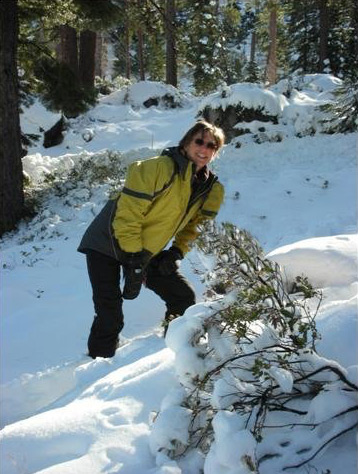 GA: In your opinion, how do you think your work is filling the knowledge gap and leading the progression of scientific community? GA: In your opinion, how do you think your work is filling the knowledge gap and leading the progression of scientific community?
PR: Most scientists hope that some of the work we do will be useful to other scientists and, if we are lucky, directly applicable to farmers in our lifetime. I feel that I have been very fortunate to have a really good lab team and wonderful collaborators and we have done some exciting work. I hope that many of the scientists I have mentored will continue with the work. I believe that any scientific advance, no matter how small, can help make the world a better place.
GA: How do you think people can become more educated about GM crops and their role in feeding our growing world population, especially those who are deprived of the basic human right of food? How can we educate the general public about it?
PR: Well, the issue is less about genetics and more about agriculture. Very few people in the United States are farmers and very few people even hear from farmers. I am often invited to join panel discussion about food and farming. Typically, there is not a single farmer on the panel. So, I think that if we could engage farmers in the conversations and discussions with consumers, it will really help a lot. For example, I think if you are a plant biologist, you understand what a seed is and that you need a seed to make a plant and that seeds have genes that encode traits that farmers need and consumers need. But that’s not so obvious to a lot of people who are not plant biologists or farmers. I believe we need to start plant biology education early—we need to help high school teachers teach their students about genetics and breeding. If there is a basic knowledge about plant breeding and the challenges faced by farmers, it will be easier for the consumers to understand that there are many different methods of genetic alterations and that we need to be thinking not about the type of genetics but how can we advance to sustainable agriculture. How can we help farmers produce enough food to feed themselves and their family and how can we help farmers farm more ecologically? How can we help reduce inputs and allow farmers to use less land and less water? Of course, it is not all about plant genetics, farmers need much more than seeds. Farmers need to use ecologically based farming practices, they need to have access to water and land, and there needs to be good government policies. It’s an interrelated system. Once we engage in dialog about sustainable agriculture, it really helps consumers think about plant genetics. Let me give you a specific example. I am opposed to the term “GMO” because it means something different to each person. And of course, everything we eat has been genetically altered in some manner. So, what I would like to see is more discussions specific to the agricultural challenge. For instance, Papaya ringspot virus infects papaya in Hawaii, which devastates the orchard and is a huge economic hardship to growers. What approaches can help farmers keep growing their crops? In this case, genetically engineered papaya to create immune papaya has worked well for more than 10 years.
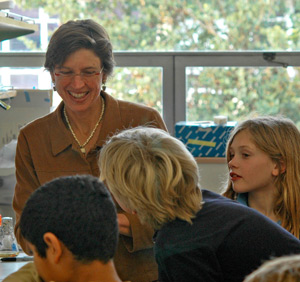 GA: What are your feelings toward the future of basic scientific research, especially in the current scenario of limited research funding? GA: What are your feelings toward the future of basic scientific research, especially in the current scenario of limited research funding?
PR: There are always ups and downs. I think that most politicians will say that they support science and that they recognize that scientific research is critical for the American economy and the global economy (even if their actions don’t always reflect that). So, I am encouraged that we do have that kind of political support, but of course, it needs to get translated into actions and support to young scientists and funding to help do the research. As scientists, we need to keep advocating for good science and engaging about science with as many nonscientists as we can. We need to try to understand the kind of issues that they are wondering about and do our best to explain why science is important.
GA: As women remain underrepresented in STEM, how can we take charge to educate more young women, get them involved in STEM, and help them to remain motivated?
PR: For women in particular?
GA: Yeah!
PR: For all of us, men and women alike, science is challenging. It is hard and you have many failures. It’s important to remember that failures are a normal part of science and help and support each other during hard times. Choose to work with people that you enjoy and trust. Support them as they support you. Be generous and kind. Share your data before publication. I don’t want to generalize too much, but it may be that there are more women than men who lack confidence in their skills and suffer from imposter syndrome. Of course, I know men who feel that way too, but it does seem to be more common in women. I hope that, once we reach a point where there are similar numbers of men and women in STEM fields, many of the challenges women now face will diminish (lack of respect, etc.) (For a great twitter story on this see: https://twitter.com/schneidremarks/status/839910253680553988?lang=en). For both men and women, having children is challenging because you love them and you love science and you want to do the best for both. But this is the case for most jobs. The good thing about science is that there is flexibility and understanding. This allows scientists who are parents to arrange their schedule so that family life will work well.
|
| — By Sophien Kamoun with contributions from LFCats
On a cloudy Norwich day in 2011, post-docs Sebastian Schornack, Sylvain Raffaele, and Tolga Bozkurt were having a typical British lunch of fish and chips with mushy peas with their supervisor Sophien Kamoun. Somehow, the discussion turned to the importance of sustained productivity. Kamoun, in his usual hyperbolic style, pointed out that now that each one of them had just published notable papers ( Schornack et al., 2010; Raffaele et al., 2010; Bozkurt et al., 2011), they should beware of not behaving like “lazy fat cats” and think hard about their next papers. Not everyone left the lunch in the happiest mood. One day later, after discussion with another post-doc, Mireille van Damme, Schornack and colleagues decided to found the Lazy Fat Cat Club (#LFCats). Schornack drafted a chart and was appointed as Chairman Féi māo ( fat cat in Mandarin). The #LFCats ethos is that productive research requires a significant amount of communication and knowledge exchange, and informally discussing research is a perfect way of solving roadblocks and laying paths for the future. Casual meetings took place on a regular basis at The Sainsbury Laboratory, mainly on afternoon coffee breaks. The club continued to loosely grow and several other researchers joined the #LFCats. As the members moved on to start their own labs, the #LFCats “brand” helped nurture a lasting bond. Suomeng Dong, now a professor in the Department of Plant Pathology at Nanjing Agricultural University, coined the Chinese proverb “ Fat cats cannot jump over the wall” to challenge the #LFCats to work collaboratively to solve problems and “jump over the wall.”
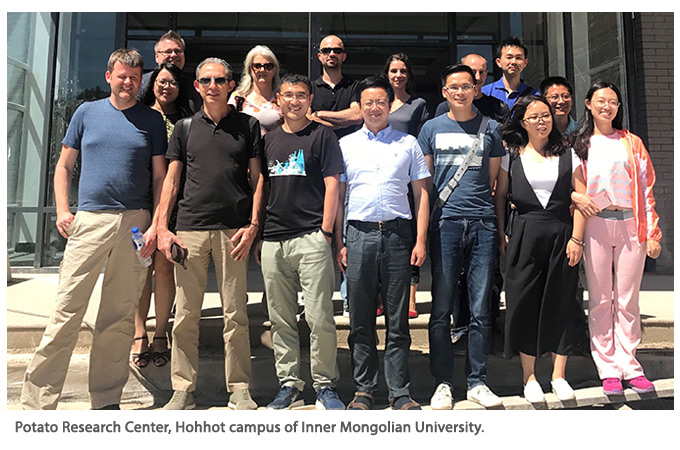
In this report, we summarize the key findings presented at the workshop.
The event kicked off with a keynote talk by Yuanchao Wang, Nanjing Agricultural University. Wang reminded the audience of the importance of oomycete diseases in China by showing dramatic photos of a potato late blight outbreak taken two weeks earlier in Kunming, Yunnan. Wang then described elegant detective work to unravel one facet of the arms-race coevolution between Phytophthora and plants. The projects started with the identification of a secreted Phytophthora sojae protein, named XEG1, that triggers hypersensitive cell death in Nicotiana benthamiana. Using a gene-silencing loss-of-function screen, Wang and colleagues identified a receptor-like protein, RXEG1, that binds XEG1 and is required for XEG1-induced ROS burst and immunity. This screen also resulted in the identification of a receptor-like kinase protein, RFX1, that forms a complex with RXEG1 and is also required for XEG1-induced immunity. XEG1 encodes hydrolase activity, and loss-of-function mutants obtained by CRISPR/Cas9 knock-outs in P. sojae revealed that XEG1 is required for full virulence on soybean via its catalytic activity. Interestingly, plants secrete a glucanase inhibitor, GIP1, that inhibits GIP1 and contributes to host resistance to P. sojae. Remarkably, XEG1 has duplicated in Phytophthora genomes, and a closely linked paralog, XLP1, present in head-to-head configuration with XEG1 in the P. sojae genome, also binds soybean GIP1 but lacks catalytic activity. Binding of XLP1 to GIP1 is essential for virulence and competes with XEG1 for GIP1 binding, thus, counteracting GIP1 contribution to host defense. Thus, P. sojae has evolved XLP1 as a decoy as a counter-defense strategy. Given that both XEG1 and XLP1 are widely distributed in Phytophthora, the XLP1 decoy has evolved early in the genus, suggesting that GIP1-type defense response is a common anti- Phytophthora defense response in plants. This works also highlights the importance of apoplastic interactions as a site of the antagonistic interactions between oomycetes and plants. Interestingly, Phytophthora also delivers RXLR effectors into host cells that suppress RXEG1-mediated immunity, highlighting a recurrent theme throughout the workshop—the endless arms race between pathogens and their hosts.
Wenbo Ma, University of California-Riverside, was another distinguished speaker to join the workshop. She described her pioneering work on Phytophthora effectors that suppress RNA silencing in plant hosts. These Phytophthora suppressors of RNA silencing (PSRs) promote infection by targeting various host regulators of RNAi. One question is why the pathogen has evolved to suppress host RNAi. Ma reported exciting new results on how host-produced phased siRNAs (or phasiRNAs) target Phytophthora genes, therefore, raising the hypothesis that host siRNAs traffic into the pathogen as a defense measure. Thus, Phytophthora PSR effectors suppress the production of these siRNAs as a counter-defense strategy in another elegant example of the continuous arms race between Phytophthora and host plants.
A second keynote speaker was Jianmin Zhou, Chinese Academy of Sciences, who centered his presentation on BIK1, a PBS1-like receptor like cytoplasmic kinase that negatively regulates immunity triggered by bacterial flagellin. Zhou reviewed the intricate dissection of the molecular mechanisms underpinning the activation of flagellin-triggered immunity in Arabidopsis; most interestingly, his recent functional genomics analyses of Arabidopsis RLCK family (46 genes) and the MAPKKK family (60 genes). This enabled him to discover that several RLCKs and MAPKKKs are involved in responses triggered by other PRRs, notably following elicitation by fungal chitin. Redundancy is the bane of genetic analysis. Zhou discussed how CRISPR/Cas9 can be used to generate multiple loss-of-function mutants to study how RLCKs cooperate to modulate plant immunity and enable a robust response of the plant to environmental perturbation. The topic of genetic redundancy, and its importance in regulating plant-pathogen interactions, was another common theme of the workshop. It is gratifying that genetic analyses have started to unravel complex network-type interactions in plant-pathogen systems.
Chih-Hang Wu, The Sainsbury Laboratory, described his work on a helper-sensor NLR immune network that also illustrates the importance of genetic redundancy in plant immunity. This NLR network includes several well-known sensor NLRs, which confer disease resistance to diverse plant pathogens, and a few helper NLRs that display varying levels of functional redundancy and specificity to different sensor NLRs. Phylogenetic analyses of plant NLR proteins revealed that this NLR network originated from an ancestral NLR pair that emerged prior to the split between caryophyllale and asterid plants. Wu also discussed how this NLR network contributes to evolvability and robustness of plant NLR-triggered immunity.
Rosa Lozano-Duran, Shanghai Center for Plant Stress Biology, started her talk by reminding us how virus proteins can be multifunctional—a lesson worth remembering for those who work on bacteria and eukaryotic pathogens. One of the challenges that viruses face is to move from cell to cell, a feat they achieve through the plasmodesmata—membrane structures that serve as cytoplasmic bridges between cells. Remarkably, antiviral RNA interference (RNAi) can also move from cell to cell in plants, allowing for systemic spread of this immune response. Lozano-Duran reported that the C4 protein of the geminivirus Tomato yellow leaf curl virus inhibits the intercellular spread of RNAi. C4 interacts with the plant protein receptor-like kinase (RLK) BARELY ANY MERISTEM 1 (BAM1) and colocalizes with this protein at plasmodesmata. BAM1 and its closest paralogue, BAM2, function as positive regulators of the cell-to-cell movement of RNAi. This work is another illustration of how pathogens have coopted host processes to favor colonization and infection.
The topic of genome-wide pathogen response to environmental cues was also covered by Kentaro Yoshida, Kobe University. Yoshida set up an ambitious experiment to monitor pathogen gene expression dynamics in field over time, ranging from daily to seasonal scales. He showed intriguing seasonal dynamics in pathogen gene expression, e.g., reporting how a set of genes are up-regulated after increases in ambient temperature or after host flowering. Yoshida also reported periodical patterns of gene expression, particularly of effector genes.
Suomeng Dong, Nanjing Agricultural University, may have the key to global patterns of gene expression regulation. For a long time, the molecular basis of DNA methylation in Phytophthora remained mysterious and the classic eukaryotic 5-methylcytosine (5mC) modification could not be reliably detected. Instead, Dong described how N6-methyldeoxyadenine (6mA) is widespread in Phytophthora and appears to modulate gene expression levels. Interestingly, unlike most eukaryotes, 6m adenine methyltransferases have duplicated and functional diversified in Phytophthora, possibly as an adaptation to the repeat-driven genome expansion.
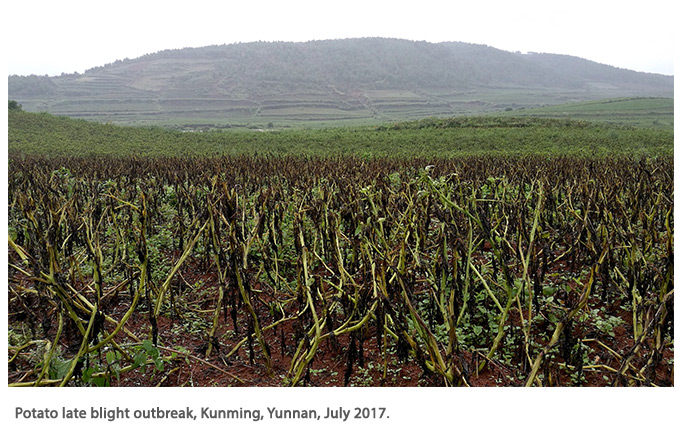
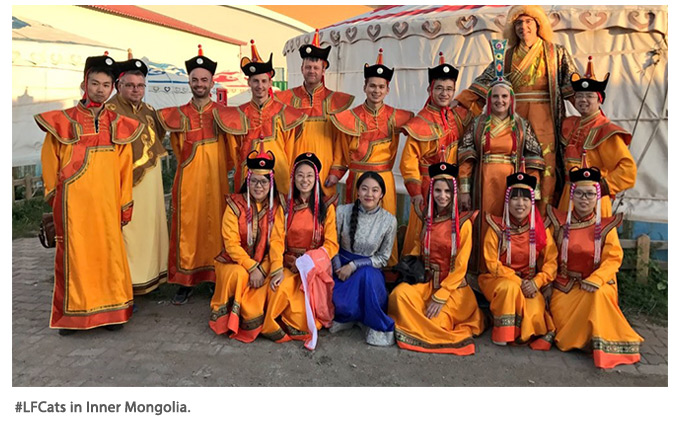 |
| This year’s Annual Meeting of The American Phytopathological Society was held in San Antonio, TX, on August 5–9.
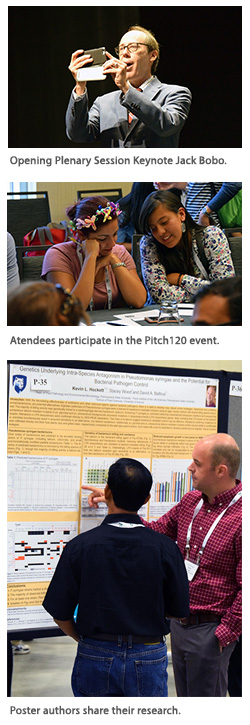 As someone whose research program is based primarily on studying molecular plant-microbe interactions, I have always found that the science presented at the APS Annual Meeting is more focused on the applied aspects of plant pathology and that the basic research kind of takes a backseat. However, there were many MPMI-focused talks and sessions, including a Special Session on “New Insights into NLR on Plant Immunity.” I have included some of the meeting highlights, including APS awards to four IS-MPMI members. As someone whose research program is based primarily on studying molecular plant-microbe interactions, I have always found that the science presented at the APS Annual Meeting is more focused on the applied aspects of plant pathology and that the basic research kind of takes a backseat. However, there were many MPMI-focused talks and sessions, including a Special Session on “New Insights into NLR on Plant Immunity.” I have included some of the meeting highlights, including APS awards to four IS-MPMI members.
The meeting began with an Opening Plenary Session led by Jack Bobo, senior vice president and chief communications officer for Intrexon (subsidiaries include Arctic apple, AquAdvantage salmon, Oxitec sterile mosquitoes). His talk, entitled “Can Agriculture Save the Planet Before It Destroys It?,” started with a live tweet of the audience cheering “Go plant health!” He followed with a discussion of global trends in food and agriculture, with a take-home message that we need to get to year 2050 without destroying the environment through agriculture (deforestation, draining aquifers). After this date, population growth will slow dramatically and productivity gains will allow us to reduce the global footprint of agriculture. Beyond 2050, he predicts that “for the first time in human history, we will not need more food.” He concluded his talk with something that stuck in my mind: “The next 35 years are not just the most important 35 years there have ever been in the history of agriculture, they’re the most important 35 years there will ever be in the history of agriculture.”
A mid-meeting Plenary Session, entitled “Changing Landscapes in Plant Pathology,” featured three early career scientists using new technologies that impact our science. This session included presenters Greg Heck, science strategy operations manager at Monsanto, who spoke on “RNA-Based Applications for Agricultural Productivity”; Erica Goss, University of Florida, who spoke on “Global Movement, Local Consequences: Using Population Genomics to Understand the Changing Landscape of Plant Pathogens”; and Lav Khot, from Washington State University, who spoke on “State-of-the-Art on Sensing Technologies for Plant Disease Detection.” Recordings of Bobo and the other plenary speakers are available online.
The Closing Session speaker was Jeff Hurt, executive vice president of Velvet Chainsaw Consulting, with a talk entitled “Making the Science of Plant Pathology Work for You: What Now? What’s Next?” His talk was focused on tools and resources to help us summarize our meeting experience and identify actionable items that we can use to impact our own research.
One of the most welcome trends I saw at the meeting was a focus on communicating our science with the public. A networking event led by the APS Office of Public Relations and Outreach trained attendees on developing their own Pitch120—a 120-second summary of their research projects that could be understood by both scientists and nonscientists. Jim Bradeen, University of Minnesota, led a session entitled “Science as Story and Story as Science: Telling Plant Pathology Research Stories.” Another session, entitled “Navigating Contentious Conversations,” was led by Paul Vincelli, University of Kentucky, and focused on engaging the public on controversial topics (GMOs, fungicide usage).
Many of the presentations at the meeting were recorded and can be purchased and viewed online.
APS members are looking forward to next year’s International Congress of Plant Pathology: Plant Health in a Global Economy, which will be held in Boston, MA, from July 29 to August 3, 2018. More information and a preliminary list of plenary and keynote talks is available at the meeting website.
Four IS-MPMI members were recognized at the meeting for their outstanding contributions to the study of plant-pathogen interactions. Thomas Baum, Iowa State University; Andrew Bent, University of Wisconsin-Madison; and Yong-Hwan Lee, Seoul National University, were named APS Fellows. APS Fellow recognition is based on significant contributions in one or more of the following areas: original research, teaching, administration, professional and public service, and/or extension and outreach.
Hailing Jin, University of California-Riverside, was given the Ruth Allen Award, which honors individuals who have made an outstanding, innovative research contribution that has changed, or has the potential to change, the direction of research in any field of plant pathology.
Each of the awardees was asked to provide their perspective on their award and provide insights/advice for aspiring young scientists. Read the interviews in this issue of Interactions. |
| 
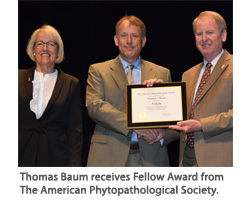 Thomas J. Baum Thomas J. Baum
Iowa State University
- What area(s) of molecular plant-microbe interactions do you feel your research has impacted most?
I think our work and that of our collaborators was instrumental in bringing plant nematology into the next phase of research questions and approaches. We led plant nematology away from pure field work aimed at identifying novel management options and toward using molecular and genomic tools to explore plant-nematode interactions.
- What advice do you have for young scientists aspiring to achieve the level of science that has major impact?
You are probably in it for the long haul. Find something you are passionate about because “(professional) life goes on long after the thrill of living (as a researcher) has gone”—John Mellencamp got it right. You need to be able to maintain your curiosity, idealism, and fun. Otherwise, you might run out of steam down the road. You need to be able to reinvent yourself and let go of old ideas to embrace new ones. Otherwise, you just might run out of funding down the road. You need to take care of your people and collaborators and be a trusted team member. Otherwise, you just might run out of friends down the road.
- When you were a post-doc, what had the largest influence on your decision to enter your specific research area in your permanent position? Was this a “hot topic” at the time, or did you choose to go in a different direction?
My field of research was not a hot topic when I entered it. I got into it because it was exciting biologically—and it still is. I listened to Dick Hussey, University of Georgia, give a talk when I was a graduate student and that was all I needed. I knew that was what I wanted to do. Sedentary nematodes delivering proteins into their host plants to reprogram plant cells to form a feeding structure is just cool. And over the years, our field developed into one of the hottest areas in plant pathology. As it turned out, we were working on effectors all these years and we never knew it! We thought we were working on nematode “spit”—how naïve ☺.
|
|  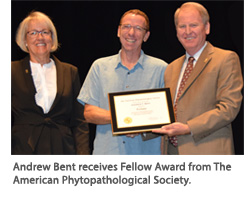 Andrew F. Bent Andrew F. Bent
University of Wisconsin - Madison
- What area(s) of molecular plant-microbe interactions do you feel your research has impacted most?
From my early days, it would have to be developing and popularizing Arabidopsis and Pseudomonas syringae as experimental models for plant pathology research and discovering that R genes encode NB-LRR proteins. A number of people contributed to that early work, which opened up whole fields of discovery. From midcareer, we had some impact with “defense-no-death” work on the hypersensitive response, improvements to floral-dip Arabidopsis transformation, and findings about flagellins and FLS2 that offered broader insights into MAMPs and MAMP receptors. Recently, our work on soybean resistance to soybean cyst nematode has been pretty big, especially in the soybean and nematology fields, because the disease and the Rhg1 locus are so important in agriculture and because we found a novel mechanism, resistance through infection-site expression of toxic versions of plant housekeeping genes.
- What advice do you have for young scientists aspiring to achieve the level of science that has major impact?
Think explicitly and extensively about all the areas you could work in, looking for the things that seem like “the future”—things that may have a higher impact because of the science or the pathosystem. Find achievable higher-impact work. Form the habit of exploratory thinking and reading and of active dreaming. When you sit in a seminar or read a paper, actively think of ways that their work could be further developed into something exciting. Do the same explicit dreaming with your own work. Then be ready to do the hard work over multiple years to make it happen.
- When you were a post-doc, what had the largest influence on your decision to enter your specific research area in your permanent position? Was this a “hot topic” at the time, or did you choose to go in a different direction?
As a post-doc, we and others had set up Arabidopsis and Pseudomonas syringae as a great pathosystem for making research progress, and our R gene discovery was brand new. So when looking to form my own lab, there were a huge number of molecular plant pathology topics out there waiting to be explored, and we did have a “hot" system in place to study them. Over time, I took things in many new directions, but coming out of my post-doc, I proposed direct offshoots of my post-doctoral work to get an assistant professor job and my first independent funding.
|
|   Yong-Hwan Lee Yong-Hwan Lee
Seoul National University
- What area(s) of molecular plant-microbe interactions do you feel your research has impacted most?
My research group has been undertaking comprehensive and integrative approaches to understand the molecular and genomic basis of fungal pathogenesis in the rice blast fungus. We also developed a powerful bioinformatics platform for comparative and evolutionary fungal genomics.
- What advice do you have for young scientists aspiring to achieve the level of science that has major impact?
Be confident and passionate! I also like to recommend to understand the complex and subtle nature of pathogenesis by combining wet lab and bioinformatics approaches as a comparative interface biology.
- When you were a post-doc, what had the largest influence on your decision to enter your specific research area in your permanent position? Was this a “hot topic” at the time, or did you choose to go in a different direction?
To understand the fundamental principles/topics on fungal infection mechanism, I chose the rice blast fungus as a model pathogen and tried to adapt cutting-edge technologies. This led to the discovery that cAMP acts as a crucial second messenger in stimulating the infection process (1993).
|
|  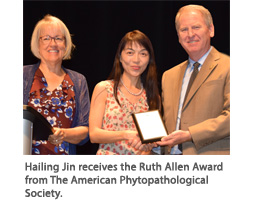 Hailing Jin Hailing Jin
University of California
- What area(s) of molecular plant-microbe interactions do you feel your research has impacted most?
I think my research has the most impact on the areas of cross-kingdom RNAi and how this affects host-pathogen communications and of small RNA and epigenetics-mediated regulation in plant-pathogen interactions.
- What advice do you have for young scientists aspiring to achieve the level of science that has major impact?
Identify a research topic or area that interests you the most, then work hard on it. It is also important to be persistent once you start a project. Don’t give up easily or get frustrated when your experiments don’t work. It is always very helpful to find a way to improve your experimental design and to find multiple alternative approaches to address the problem and confirm your findings.
- When you were a post-doc, what had the largest influence on your decision to enter your specific research area in your permanent position? Was this a “hot topic” at the time, or did you choose to go in a different direction?
I have always been interested in developing eco-friendly strategies and effective means to increase the quality and production of crops. During my post-doctoral training in Barbara Baker’s lab at the Plant Gene Expression Center, at the University of California-Berkeley, I used a virus-induced gene silencing approach to dissect the signal transduction pathway of Tobacco mosaic virus-resistance gene N, which not only attracted me to the plant defense and small RNA world but also allowed me to gain experience in all the small RNA techniques. At that time, the important role of small RNAs in plant development was just emerging, but very few labs were working on the role of small RNAs in stress responses, especially in the field of plant immune responses against bacterial and fungal pathogens. After I got my independent position, I felt that it would be an excellent opportunity for me to start a new research direction—regulatory role of small RNAs in plant immunity—instead of continuing working on the hot topic “plant resistance genes.” This research area is my passion and I will continue to work on improving our crops and food for many years to come.
|
| A new whitepaper published in Molecular Plant-Microbe Interactions, entitled “Foundational and Translational Research Opportunities to Improve Plant Health,” offers a detailed accounting of deliberations at a recent workshop focused on the various biotic challenges to maintaining plant health.
This fully open-access paper provides an outline and an accounting of the discussions between Richard W. Michelmore, University of California, Davis; MPMI Editor-in-Chief John M. McDowell; and nearly 40 other researchers at the British Embassy in Washington, DC, in late 2016.
Members are encouraged to view the whitepaper and extend this engaging conversation about the many challenges and solutions for maintaining the quality and productivity of crops to secure food for the rapidly growing human population.
MPMI and the participants invite reader comments about this paper. Visit apsjournals.apsnet.org/page/MPMI-01-17-0010-CR to become part of this important and timely discussion.
 |
|
We are pleased to announce that the next iteration of the IS-MPMI Congress will take place among the beautiful vistas only found in Scotland. During July 14–18, 2019, you will be able to interact with your molecular plant-microbe interactions community from around the world. Witness the majesty and history of this magical land while you engage and participate in stimulating lectures. Keep an eye on the congress website for more information. It is never too early to start making plans for this exciting event!
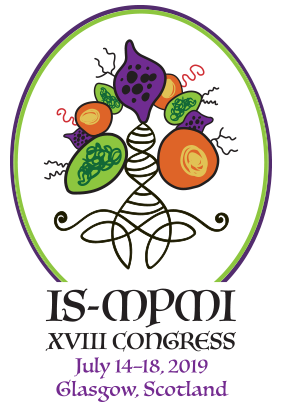
 |
Follow javascript: SP.SOD.executeFunc('followingcommon.js', 'FollowDoc', function() { FollowDoc('{ListId}', {ItemId}); }); 0x0 0x0 ContentType 0x01 1100 Compliance Details javascript:if(CalloutManager && CalloutManager.closeAll) CalloutManager.closeAll(); commonShowModalDialog('{SiteUrl}'+
'/_layouts/15/itemexpiration.aspx'
+'?ID={ItemId}&List={ListId}', 'center:1;dialogHeight:500px;dialogWidth:500px;resizable:yes;status:no;location:no;menubar:no;help:no', function GotoPageAfterClose(pageid){if(pageid == 'hold') {STSNavigate(unescape(decodeURI('{SiteUrl}'))+
'/_layouts/15/hold.aspx'
+'?ID={ItemId}&List={ListId}'); return false;} if(pageid == 'audit') {STSNavigate(unescape(decodeURI('{SiteUrl}'))+
'/_layouts/15/Reporting.aspx'
+'?Category=Auditing&backtype=item&ID={ItemId}&List={ListId}'); return false;} if(pageid == 'config') {STSNavigate(unescape(decodeURI('{SiteUrl}'))+
'/_layouts/15/expirationconfig.aspx'
+'?ID={ItemId}&List={ListId}'); return false;}}, null); 0x0 0x1 ContentType 0x01 898 Document Set Version History /_layouts/15/images/versions.gif?rev=40 javascript:SP.UI.ModalDialog.ShowPopupDialog('{SiteUrl}'+
'/_layouts/15/DocSetVersions.aspx'
+ '?List={ListId}&ID={ItemId}') 0x0 0x0 ContentType 0x0120D520 330 Send To other location /_layouts/15/images/sendOtherLoc.gif?rev=40 javascript:GoToPage('{SiteUrl}' +
'/_layouts/15/docsetsend.aspx'
+ '?List={ListId}&ID={ItemId}') 0x0 0x0 ContentType 0x0120D520 350
|
|
|
|
